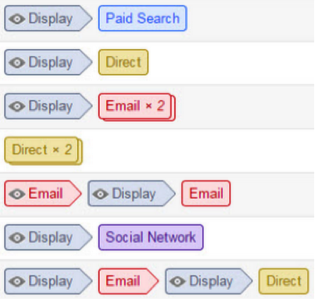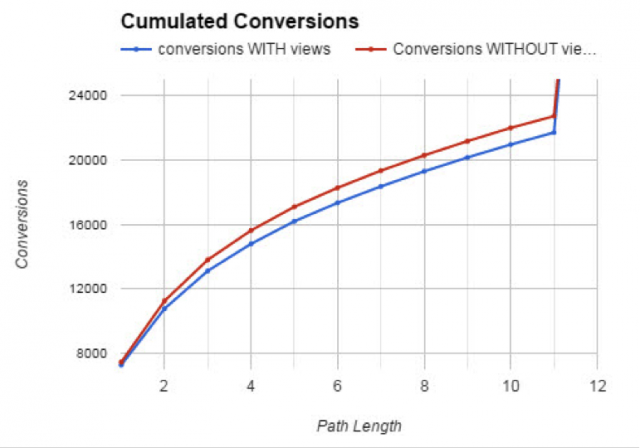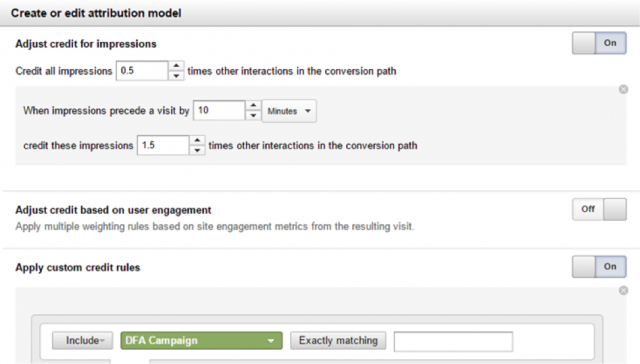The idea of measuring the full customer journey has been around for quite a while, and we have seen solutions that partially solved this challenge, but within the boundaries of click-only traffic or paid-only channels.
Historically it has been difficult to integrate ad views without clicks, generic traffic channels (direct, organic, referral) and cross-device journeys within one holistic view. With the integration of Google Analytics Premium and the DoubleClick Campaign Manager (DCM) all of this is available NOW.
All touchpoints included in the channel path
Once you integrate Google Analytics Premium and DoubleClick Campaign Manager, when you take a closer look at the Google Analytics Multi-Channel-Funnels (MCF) path analysis report, you will notice some special features, as seen in the screenshot below.

All touchpoints, where users have viewed a display ad on the journey to conversion (even without clicking on it), are marked with the eye icon. Bear in mind that in this case we do not only measure classic display ad views, but also email newsletters that have been opened, but not clicked. This leads to insights as illustrated in the following path.

In this scenario the newsletter was opened, but obviously didn’t attract enough attention to yield a click. Later on, a display ad supported the customer journey, which led to a reopening of the email, a click within the email and lastly a conversion.
Look around for articles on how to gain insights from attribution modeling leading to campaign and media optimization. Typical questions are:
- How do my e-mail campaigns support my revenue?
- Which other channels get support from email?
- What other channels are necessary for email to perform well?
- How do display views influence the path length?
Path length and time with and without view attribution
Having only partial insights (and data) from the customer journey leads to wrong assumptions and decisions. Here is the comparison of the path length for a specific goal, with and without taking the view contacts into account.

Without taking the views into account, we would think that we need fewer interactions than we actually do. This assumption is made even worse when we look into the assists. In the screenshot below, the views are NOT included. Here we see 42 assisting clicks to the conversion and the assisted conversion value of €2,285.

When we look into the same data WITH attribution of the ad-views, we see the ads assisting the goal 895 times – 20 times more! And the assisted conversion value is €33,716, which is €31,431 higher than in the previous screenshot!

Without attributing the views, the display channel seems worthless. A wrong conclusion would be to decrease media spend for that channel and shift it to the “performance” channels. This could result in a loss of awareness in the upper funnel, which could lead to lower conversions and ROI: a fatal error for most businesses out there.
But what is the value of a view?
We often get asked: “But has a simple ad view the same value as a click?” This is a valid question, as a click is a clear indication of interest, whereas a view is only the technical delivery of an ad to the user’s browser; we cannot determine whether it has really been seen or whether it was of any interest.
This is why the Google Analytics attribution modeling engine offers us the option to customize its models in multiple ways. In this article I want to emphasize the adjustments regarding ad views:
As shown in the screenshot below, we can define that
- in general a view should only be attributed 50% of the value of a click (0.5)
- however, if a view is followed by a click within 10 minutes, it should be counted as 150% (1.5)
- and if a click did not lead to conversion directly but to a visit with a higher user engagement (time on site > x:xx), it should be valued at yyy%

Conclusion
As we all know, the future of marketing is data driven. Having only fraction of the data leads to suboptimal and sometimes inaccurate decisions. The 360 integration of all channels (click AND view interactions) and a successful cross-device measurement (online AND offline) is the key to success. Google Analytics Premium and DoubleClick Campaign Manager offer a supreme solution for that with the power of data in a well known user interface. That enables businesses gaining the right insights for the best strategies.
This article is also available in german: Full customer Journey Analyse mit Analytics und DoubleClick








